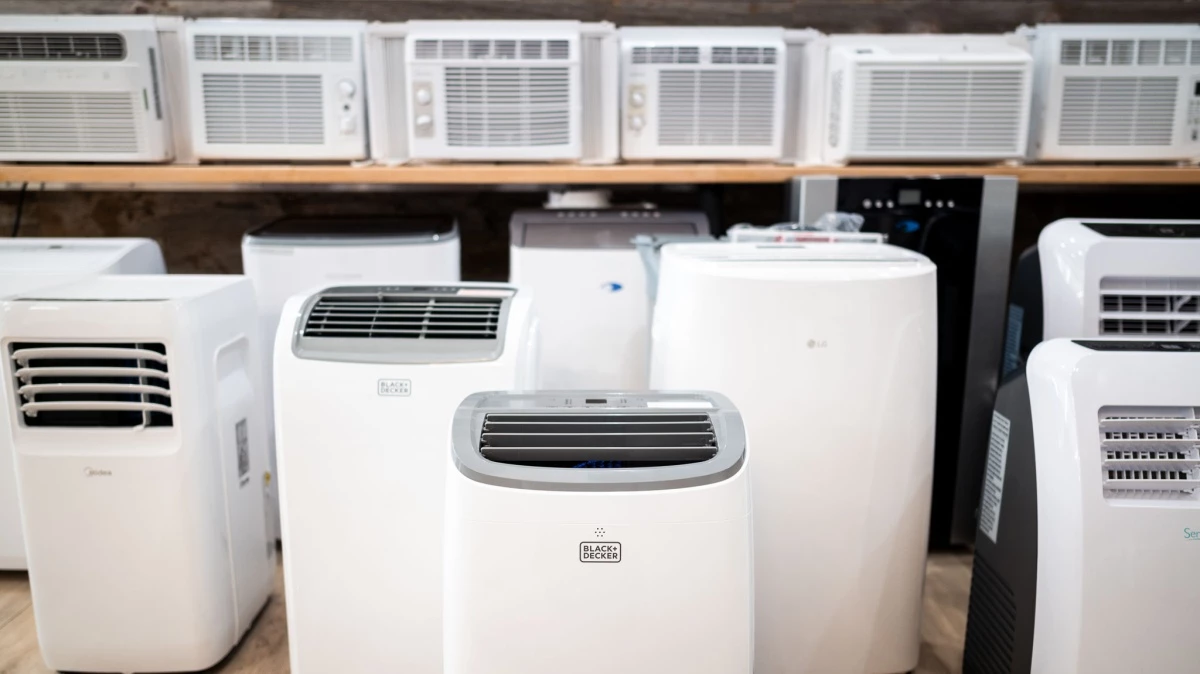Summer in the US is getting hotter every year, and having a reliable air conditioner is no longer a luxury—it’s a necessity. Whether you live in a small apartment, a home office, or a large open-plan house, choosing the right AC can save energy, reduce costs, and keep your living space comfortable. In 2025, both window and portable air conditioners have evolved with advanced features such as inverter technology, smart apps, and energy-saving modes. This guide breaks down the best ACs of 2025, comparing their cooling power, energy efficiency, noise levels, and extra features to help you make an informed decision.
1. Top Air Conditioner Brands in 2025

Several brands have stood out in 2025 for performance, reliability, and advanced features:
- Midea: Known for its innovative U-shaped window ACs, Midea combines powerful cooling with energy efficiency and smart features.
- LG: A long-trusted brand, LG offers both window and portable ACs with quiet operation, smart connectivity, and eco-friendly technology.
- Samsung: Samsung’s Wind-Free series includes AI-driven controls, Wi-Fi connectivity, and quiet cooling, making it a top pick for smart homes.
- Frigidaire & GE: Affordable, reliable, and energy-efficient, these brands excel in budget-friendly ACs.
- Whynter & SereneLife: Leading portable ACs that are easy to install, move between rooms, and provide high BTU output.
These brands have been rigorously tested across cooling efficiency, noise levels, and energy use to determine which models truly perform best in real-life conditions.
2. Best Window Air Conditioners in 2025
Window ACs remain the most energy-efficient solution for cooling single rooms. By keeping the compressor outside the house, they save electricity and minimize indoor noise.
Midea U-Shaped MAW08V1QWT – Best Overall Window AC
- BTU: 8,000
- Price: $296
- Pros: Energy-efficient, app-compatible, full window functionality, quiet
- Cons: Installation can be cumbersome, child lock is limited
The Midea U-Shaped design puts the noisiest parts outside, making indoor operation quiet. Its inverter technology reduces energy consumption, and smart app integration allows temperature control from your phone or through Alexa/Google Assistant. Perfect for small-to-medium rooms, it balances performance with efficiency.

LG LW6017R – Best Value Window AC
- BTU: 6,000
- Price: $186
- Pros: Low energy use, useful remote, digital display, budget-friendly
- Cons: Louder than premium models, installation can be tricky
LG’s LW6017R is ideal for rooms up to 260 sq. ft. While it lacks inverter technology, it performs exceptionally well at a modest price. The eco-mode helps reduce energy costs without sacrificing comfort.
GE AHEC05AC – Best for Low Energy Consumption
- BTU: 5,050
- Price: $175
- Pros: Simple design, quick setup, highly energy-efficient
- Cons: Noisy, lacks temperature indicator
This compact GE model is perfect for small rooms under 150 sq. ft. Its affordability and energy efficiency make it a top choice for those on a strict budget.
3. Best Portable Air Conditioners in 2025
Portable ACs provide flexibility for renters or those who move units between rooms. They are generally easier to install than window units but take up some floor space and are slightly noisier.
Whynter ARC-1230WN – Best Overall Portable AC
- BTU: 12,000
- Price: $585
- Pros: Powerful cooling, inverter technology, child lock, app and remote control
- Cons: Heavy, slightly cumbersome to move
The Whynter ARC-1230WN cools large rooms quickly and efficiently. It’s especially suitable for open-plan areas or rooms with high ceilings, combining power with energy efficiency.
SereneLife SLPAC10 – Best Lightweight Portable AC
- BTU: 10,000
- Price: $400
- Pros: Easy setup, portable, budget-friendly
- Cons: Minimal features, slightly noisy
Lightweight and simple to operate, the SereneLife SLPAC10 is perfect for small-to-medium rooms. It’s ideal for users who need a portable solution without breaking the bank.
LG LP1022FVSM – Best Silent Portable AC
- BTU: 14,000
- Price: $719
- Pros: Very quiet, smart app controls, powerful cooling
- Cons: Expensive, display placement could be better
For noise-sensitive environments, the LG LP1022FVSM is unmatched. At only 56 decibels, it’s quiet enough to run while working or napping, while still offering strong cooling for large rooms.
4. How to Choose the Right AC in 2025

Selecting the right air conditioner depends on room size, energy efficiency, and your lifestyle.
a. Room Size and BTU
- Up to 200 sq. ft.: 6,000–8,000 BTUs
- 200–300 sq. ft.: 8,000–10,000 BTUs
- 300–500 sq. ft.: 10,000–14,000 BTUs
- 500+ sq. ft.: 14,000+ BTUs
Always consider windows, insulation, and sun exposure when choosing BTU. For south-facing rooms or spaces with high ceilings, slightly higher BTUs may be needed.
b. Energy Efficiency
- Inverter technology adjusts compressor speed based on temperature, saving electricity.
- Window ACs are generally more efficient than portable units.
- Smart apps allow scheduling and eco-modes to reduce costs.
Energy-efficient models have higher upfront costs but save money in the long run while being environmentally friendly.
c. Noise Level
- Window ACs are quieter indoors since the compressor is outside.
- Portable units are slightly louder due to indoor compressors.
- Models like LG LP1022FVSM offer nearly silent operation.
d. Extra Features
- Smart app controls: Timer, temperature, and scheduling.
- Child locks: Useful for families.
- Smart home compatibility: Works with Alexa or Google Assistant.
- Airflow and mode options: 5-in-1 cooling, sleep mode, wind-free mode.
5. Installation and Convenience
- Window ACs require brackets and sometimes two people for installation. They block part of your window but remain stationary for the season.
- Portable ACs need venting through a window but can be moved between rooms. They occupy floor space but are renter-friendly.
Consider your living situation, mobility needs, and installation preferences when selecting between these two types.
6. Conclusion
Choosing the best air conditioner in 2025 involves balancing room size, energy efficiency, noise levels, and smart features. For window ACs, the Midea U-Shaped MAW08V1QWT stands out for most households, while budget-conscious buyers may prefer the LG LW6017R or GE AHEC05AC. For portable options, Whynter ARC-1230WN is best for large spaces, SereneLife SLPAC10 is ideal for lightweight mobility, and LG LP1022FVSM is perfect for silent operation.
With rising temperatures, having a reliable AC is essential. Consider your specific needs, BTU requirements, and smart features to select an air conditioner that keeps your home cool and energy-efficient throughout 2025.
Frequently Asked Questions (FAQ)
1. What is the best air conditioner for small rooms in 2025?
For rooms under 200 sq. ft., the LG LW6017R or GE AHEC05AC are top choices. They are energy-efficient, affordable, and easy to install.
2. Are portable air conditioners as effective as window ACs?
Portable ACs are effective for medium to large rooms but are slightly less energy-efficient than window units. They are ideal for renters or rooms where window installation isn’t possible.
3. How do I choose the right BTU for my room?
Use this guide:
- Up to 200 sq. ft.: 6,000–8,000 BTU
- 200–300 sq. ft.: 8,000–10,000 BTU
- 300–500 sq. ft.: 10,000–14,000 BTU
- 500+ sq. ft.: 14,000+ BTU
Consider insulation, ceiling height, and sun exposure for accuracy.
4. Which AC is the quietest in 2025?
The LG LP1022FVSM portable AC and Midea U-Shaped window AC are among the quietest models, operating under 56 decibels.
5. Are smart air conditioners worth it?
Yes. Smart ACs offer remote control via apps, scheduling, energy-saving modes, and compatibility with Alexa or Google Assistant, providing convenience and cost savings.
6. How much does it cost to run an AC in the US?
It depends on the AC type, room size, and usage hours. Energy-efficient models with inverter technology generally cost $20–$50 per month for regular usage during summer months.
7. Can I install a window AC myself?
Yes, small to medium units can be installed by one or two people with proper brackets. Always follow manufacturer instructions for safety and optimal cooling.
8. How often should I clean my AC filter?
For optimal performance, clean the filter every 2–4 weeks for window ACs and portable units, especially during heavy usage.

